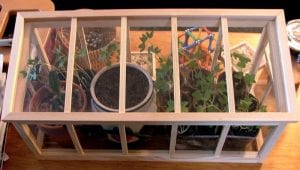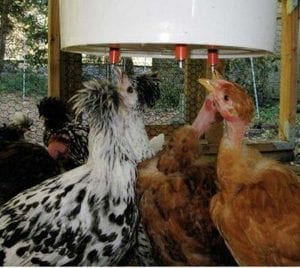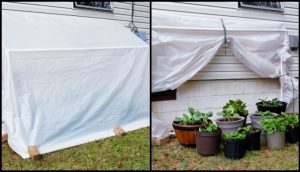Last Updated on February 29, 2024 by teamobn
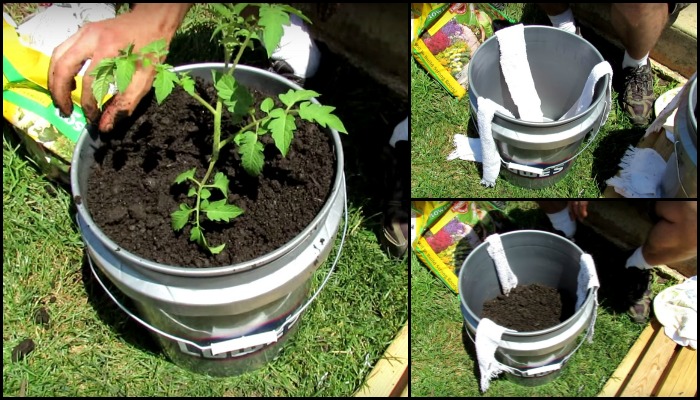
Tomatoes are a type of fruit that is commonly used in a variety of dishes. They are a good source of vitamins and minerals and can be eaten raw or cooked. Tomatoes can be used in salads, soups, pasta sauces, and a variety of other dishes.
Raw tomatoes are a great source of vitamins and minerals and can be used in salads or as a healthy snack. Cooked tomatoes are also a nutritious option, and can be used in soups, pasta sauces, and a variety of other dishes.
No matter how you enjoy them, tomatoes are a delicious and nutritious option that can be enjoyed as part of a healthy diet. Nothing compares to the taste of fresh, homegrown tomato. Plus, planting your own tomatoes is a great way to get some exercise and enjoy the outdoors.
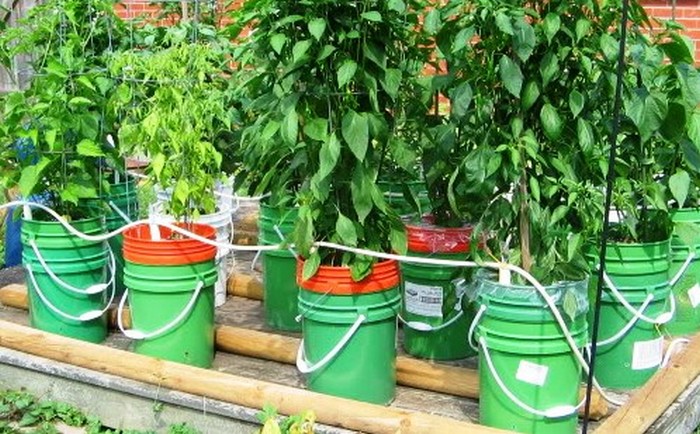
If you’re a bit short on time because of a busy schedule, there’s still a way for you to enjoy gardening. What you need are a little imagination and a little creativity! Here’s a great idea that makes gardening possible for busy owners. Are you one of them and you want to grow some tomatoes? Then this is definitely for you!
A self-watering tomato planter! A self-watering tomato planter is a perfect solution for anyone who wants to enjoy fresh, delicious tomatoes without having to worry about daily watering. This container garden features a built-in watering system that can take care of your tomatoes for 2-3 days at a time, providing a hassle-free way to grow your own tomatoes at home.
Plus, the self-watering design means that your tomatoes will always have the perfect amount of moisture, resulting in healthier plants and bigger, better tomatoes. This self-watering tomato planter is great to have if you constantly forget to water your plants, you’re too busy with other daily tasks, or planning to go on a weekend getaway!
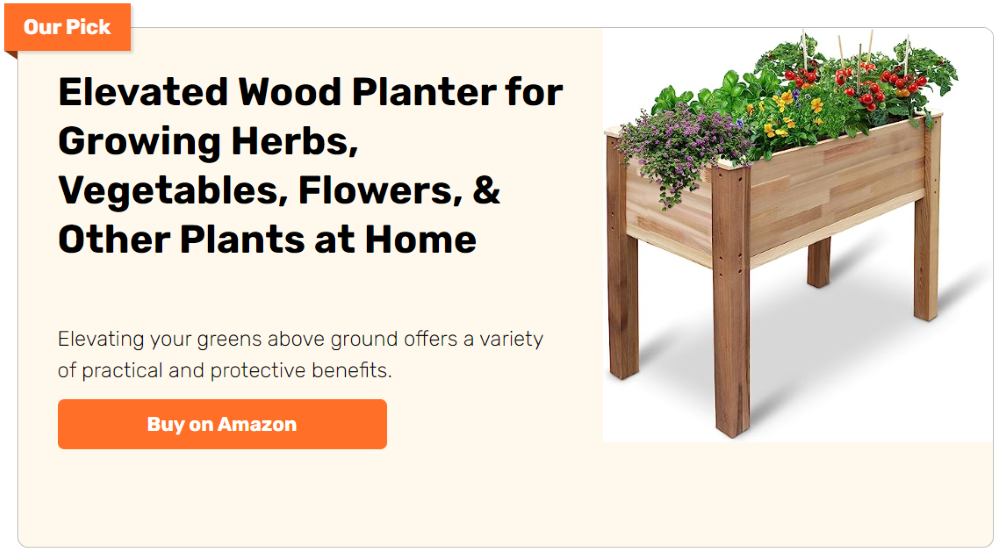
It makes use of 5-gallon buckets, but we don’t recommend getting one that previously contained other substances, like paint. You don’t want any chemicals seeping into your plant! You can find cheap buckets from your local stores, and even Amazon has a relatively inexpensive 5-gallon bucket.
This self-watering tomato garden container is also a good DIY project for people new to gardening or DIYs because it’s simple and easy to build!
Click on any image to start the lightbox display. Use your Esc key to close the lightbox.![]()
Contents [show]
Advantages of Self-Watering Tomato Planter
Self-watering tomato planters offer several advantages for gardeners, making them a popular choice for growing tomatoes and other vegetables. Here are some key benefits:
1. Water Efficiency: Self-watering planters are designed to provide plants with a consistent supply of water, reducing the risk of under or overwatering. The built-in reservoir allows plants to draw water as needed, ensuring they receive adequate moisture without wastage. This water efficiency is particularly beneficial during hot summer months when plants require more hydration.
2. Consistent Moisture Levels: With a self-watering system, moisture levels in the soil remain more consistent, creating optimal growing conditions for plants. This helps to prevent fluctuations in soil moisture that can stress plants and lead to issues such as blossom end rot or split fruits. Consistent moisture also promotes healthy root development and encourages robust growth.
3. Reduced Maintenance: Self-watering planters require less frequent watering compared to traditional pots or garden beds. The built-in reservoir can hold enough water to keep plants hydrated for several days or even weeks, depending on the size of the planter and the water requirements of the plants. This reduces the need for daily watering and allows gardeners to spend less time maintaining their plants.
4. Extended Watering Intervals: One of the key advantages of self-watering planters is their ability to sustain plants during periods of absence or vacation. Gardeners can fill the reservoir before leaving, providing plants with a continuous water supply while they are away. This ensures that plants remain healthy and hydrated even in the gardener’s absence, minimizing the risk of wilting or dehydration.
5. Improved Plant Health: Consistent moisture levels and adequate hydration contribute to overall plant health and vigour. Self-watering planters help to prevent stress-related issues such as wilting, leaf curling, or stunted growth, resulting in healthier and more productive plants. By providing plants with the ideal growing conditions, self-watering planters support robust root development and vigorous foliage growth.
6. Weed Suppression: Self-watering planters can help suppress weed growth by keeping the soil surface consistently moist. This reduces the germination and establishment of weed seeds, limiting the need for manual weeding or the use of herbicides. Additionally, the confined space of the planter can make it easier to spot and remove any weeds that do emerge.
7. Space Optimization: Self-watering planters are available in a range of sizes and designs, making them suitable for gardens of all sizes, including small balconies, patios, or urban spaces. Their compact footprint allows gardeners to maximize growing space and grow tomatoes in areas where traditional gardening methods may not be feasible.
Vertical or hanging self-watering planters can also be used to make efficient use of vertical space, ideal for gardeners with limited ground space.
8. Enhanced Yield and Flavor: By providing plants with consistent moisture and optimal growing conditions, self-watering planters can result in higher yields and better-tasting tomatoes. Well-hydrated plants are more likely to produce abundant fruits with fewer issues such as cracking or blossom end rot. The controlled watering regime also helps to concentrate flavours, resulting in sweeter, more flavorful tomatoes.
Overall, self-watering tomato planters offer numerous advantages for gardeners, from water efficiency and reduced maintenance to improved plant health and enhanced yields. With their convenience and effectiveness, these planters are a valuable tool for growing healthy and productive tomato plants in any garden setting.
Been wanting to grow your own tomatoes? Then this self-watering tomato planter must be the idea you’ve been looking for!
How to Make Your Self-Watering Tomato Planter
You’ll need these materials:
- 2 Five Gallon Paint Buckets
- 2 Standard Kitchen Sponges
- 1 Cotton Towel
- 1 Small Funnel
- Planting Mix (with ‘moisture control’ label)
- PVC Pipes
And these tools:
- Scissors
- Sharp Knife
- Clippers (optional)
- Drill with 1/4 inch bit (optional)
- Garden Trowel
Steps:
1. To make a self-watering tomato planter, you will need two 5-gallon buckets. The first bucket will serve as the planter, and the other one will serve as a water reservoir. To make the planter, drill a hole in the bottom of the first bucket.
2. The hole should be big enough to fit a piece of cotton towel. This will allow water to slowly seep out of the reservoir and into the planter. When you fill the reservoir with water the cotton towel will absorb it, it will then distribute the water it absorbs in the planter.
3. Use the sponge to hold the towel, one on the bottom of the inside part planter and the other one should be on the outside. Then drill a hole in the second container, this will serve as the water inlet when you refill the bucket with water or nutrients.
Finally, you can plant your tomatoes in this self-watering tomato planter!
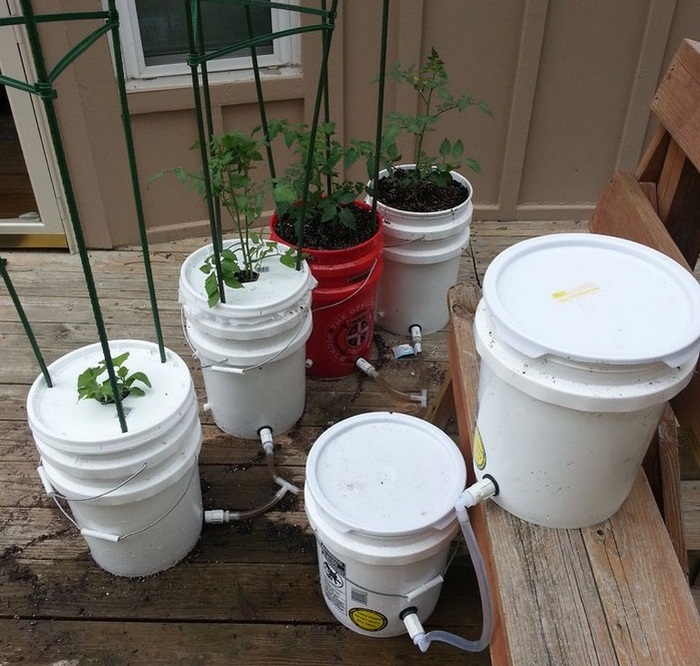

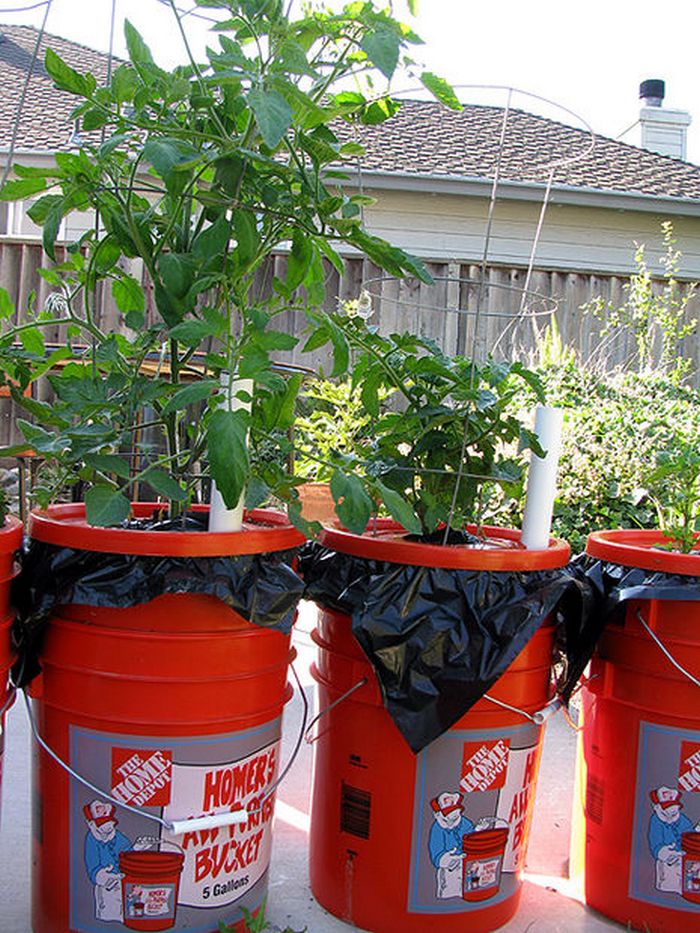
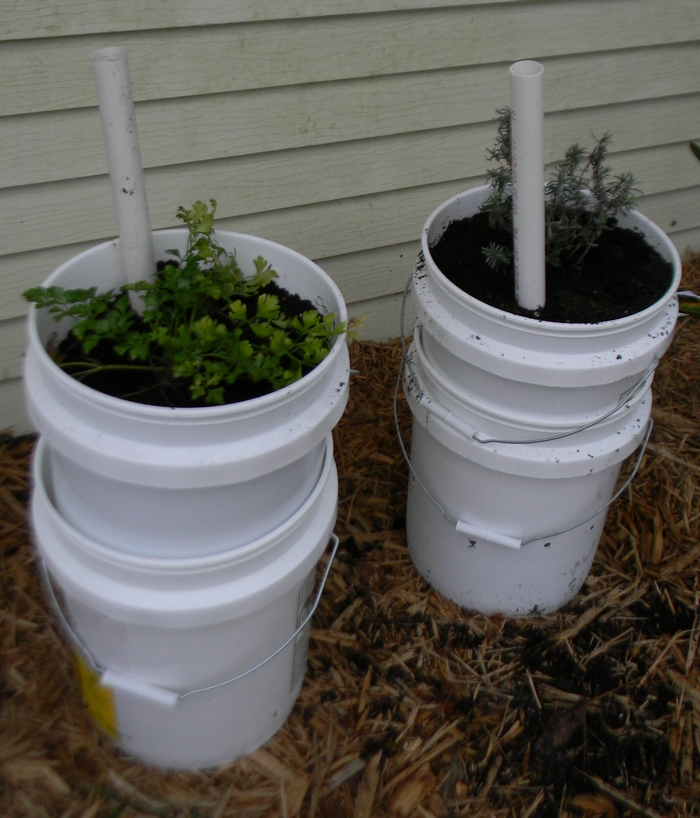
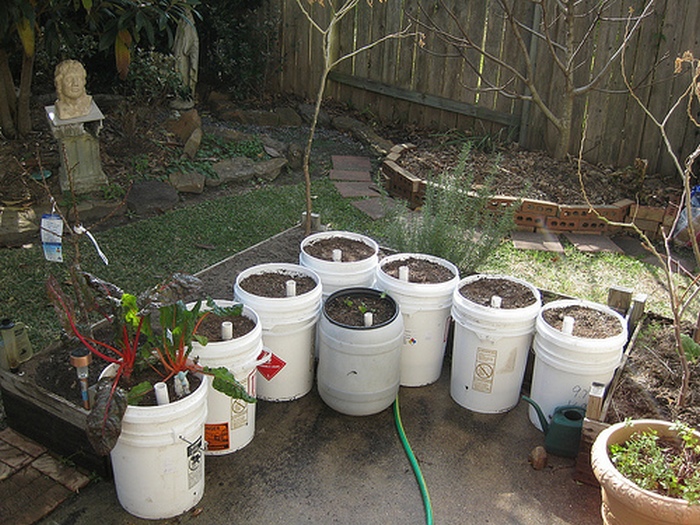

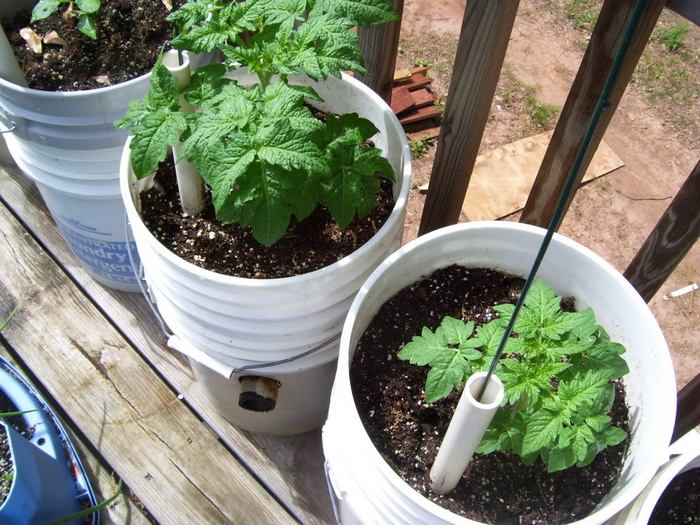
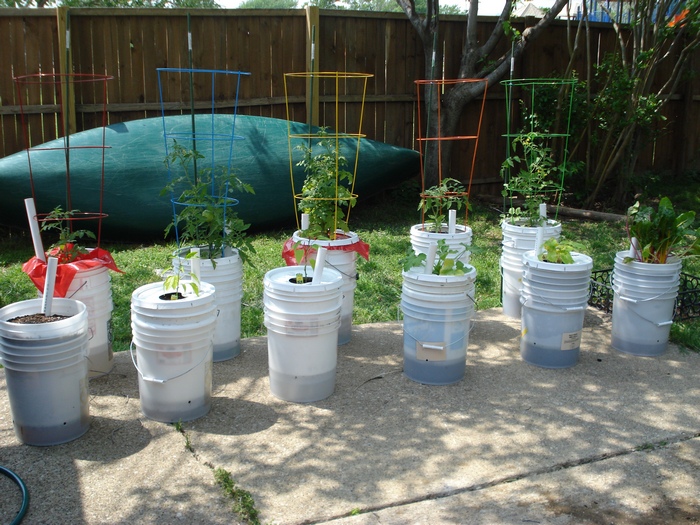

Thanks to TheRustedGarden for sharing tips and strategies on this great project!
Maintaining Your Self-Watering Tomato Planter
Maintaining a self-watering tomato planter is essential to ensure optimal plant health and productivity. Here are some key maintenance tasks to keep your planter in top condition:
1. Monitor Water Levels: Regularly check the water level in the planter’s reservoir to ensure it remains adequately filled. Depending on factors such as temperature, humidity, and plant size, you may need to refill the reservoir every few days or weeks. Avoid letting the reservoir run dry, as this can stress the plants and lead to wilting or nutrient deficiencies.
2. Clean the Reservoir: Periodically clean the reservoir to prevent algae growth, mineral buildup, or bacterial contamination. Empty the reservoir and rinse it with clean water to remove any debris or sediment. If necessary, scrub the reservoir with a mild detergent or vinegar solution to remove stubborn deposits. Rinse thoroughly before refilling with fresh water.
3. Check Soil Moisture: Monitor the moisture level in the soil regularly to ensure it remains within the optimal range for tomato plants. Insert your finger into the soil up to the second knuckle to gauge moisture levels. If the soil feels dry, it’s time to water the plants. Avoid overwatering, as excessive moisture can lead to root rot or fungal diseases.
4. Fertilize Appropriately: Tomatoes are heavy feeders and require regular fertilization to thrive. Use a balanced fertilizer formulated for tomatoes and follow the manufacturer’s recommendations for application rates and frequency. Avoid over-fertilizing, as this can lead to nutrient imbalances or salt buildup in the soil. Consider using a slow-release fertilizer to provide a steady supply of nutrients over time.
5. Prune and Train Tomato Plants: Regular pruning and training help to promote healthy growth and improve airflow around the plants, reducing the risk of disease. Remove any suckers that emerge from the leaf axils and trim back excess foliage to encourage fruit production. Use stakes or trellises to support the tomato plants and prevent them from sprawling on the ground.
6. Inspect for Pests and Diseases: Keep an eye out for signs of pests or diseases on your tomato plants, such as yellowing leaves, holes in foliage, or insect activity. If you notice any suspicious symptoms, inspect the plants closely and take appropriate action to control the problem. Consider using organic pest control methods whenever possible to minimize environmental impact.
7. Mulch the Soil: Apply a layer of organic mulch, such as straw, shredded leaves, or grass clippings, around the base of the tomato plants. Mulch helps to conserve soil moisture, suppress weeds, and regulate soil temperature, creating optimal growing conditions for tomatoes. Refresh the mulch layer as needed to maintain its effectiveness throughout the growing season.
8. Clean and Sterilize Tools: Regularly clean and sterilize gardening tools such as pruners, stakes, and trellises to prevent the spread of pests and diseases. Wipe down tools with a disinfectant solution or rubbing alcohol after each use, especially if you’ve been working with diseased plants. This helps to minimize the risk of contamination and keep your tomato plants healthy.
By following these maintenance tips, you can ensure that your self-watering tomato planter remains in excellent condition and continues to provide bountiful harvests of delicious tomatoes season after season.
The Wrap Up
The conclusion of crafting a self-watering tomato planter is not just the culmination of a DIY project; it’s the beginning of a journey towards sustainable gardening and bountiful harvests. As the final touches are put in place and the planter is set up, gardeners embark on a path that promises convenience, efficiency, and the joy of homegrown produce.
At its essence, the self-watering tomato planter represents a harmonious blend of innovation and simplicity. By harnessing the principles of self-regulating hydration, this system ensures that tomato plants receive the moisture they need without the constant manual effort of traditional watering methods. With a reservoir beneath the soil, capillary action draws water upward to the roots, promoting healthy growth and abundant fruiting. As gardeners bid farewell to the chore of daily watering, they welcome a newfound ease and convenience into their gardening routine.
Furthermore, the conclusion of creating a self-watering tomato planter heralds a sense of empowerment and self-sufficiency. No longer reliant on external factors like weather patterns or watering schedules, gardeners take control of their growing environment and cultivate tomatoes on their own terms.
Whether in a backyard garden, on a balcony, or in a small urban apartment, this self-contained system offers the freedom to grow fresh produce wherever there’s space and sunlight. With a sense of pride and accomplishment, gardeners revel in the ability to nourish themselves and their families with homegrown tomatoes, knowing that they’ve played a direct role in their food’s journey from seed to table.
Moreover, the conclusion of the self-watering tomato planter project underscores the importance of sustainability and resource conservation in modern gardening practices. By minimizing water waste and optimizing hydration through efficient design, gardeners reduce their environmental impact and promote responsible stewardship of natural resources. With each tomato harvested from their planter, they’re reminded of the interconnectedness of all living things and the role they play in preserving the health of the planet for future generations.
Additionally, the conclusion of crafting a self-watering tomato planter fosters a deeper connection to nature and the cycle of life. As gardeners observe the growth and development of their tomato plants, from tiny seedlings to robust vines laden with fruit, they’re reminded of the miraculous process of germination, growth, and reproduction that sustains all living organisms.
With each blossom that transforms into a ripe tomato, they witness the beauty and resilience of the natural world, reaffirming their appreciation for the wonders of life and the power of nurturing living things.
In conclusion, the self-watering tomato planter represents more than just a gardening tool; it’s a testament to human ingenuity, environmental stewardship, and the enduring bond between humans and nature.
As gardeners reflect on the journey they’ve undertaken and the fruits of their labour, they’re filled with a sense of satisfaction and fulfillment, knowing that they’ve created something meaningful and impactful. With the conclusion of this project comes not only the promise of delicious tomatoes but also the realization that with a little creativity and determination, anything is possible in the garden.
Frequently Asked Questions
1. What materials do I need to make a self-watering tomato planter?
To make a self-watering tomato planter, you’ll need a large plastic container with a lid, a smaller container to hold the soil and plants, a wicking material such as cotton rope or felt, potting mix, tomato seedlings or seeds, and water.
2. How does a self-watering tomato planter work?
A self-watering tomato planter works by using a reservoir of water at the bottom of the container. The wicking material absorbs water from the reservoir and delivers it to the soil where the plants’ roots can access it. This ensures that the plants receive a consistent supply of water without the need for daily watering.
3. Do you need to drill holes in the containers for drainage?
While drainage holes are typically necessary in traditional planters, they are not required for self-watering containers. The reservoir at the bottom of the planter holds excess water, preventing it from saturating the soil and causing root rot. However, it’s essential to ensure that the wicking material can reach the reservoir to facilitate water uptake.
4. How often do you need to refill the water reservoir?
The frequency of refilling the water reservoir depends on factors such as the size of the container, the weather conditions, and the water requirements of the tomato plants. In general, you may need to refill the reservoir every few days to a week, especially during hot and dry weather when evaporation rates are higher.
5. Can you use any type of tomato plant in a self-watering planter?
Self-watering tomato planters are suitable for various tomato varieties, including determinate and indeterminate types. However, it’s essential to choose compact or bush varieties for smaller containers to prevent overcrowding and ensure adequate space for root growth.
6. Can you grow other vegetables or herbs in a self-watering tomato planter?
Yes, self-watering planters are versatile and can be used to grow a variety of vegetables, herbs, and even flowers. However, it’s essential to consider the space requirements and water needs of each plant species to ensure successful growth.


